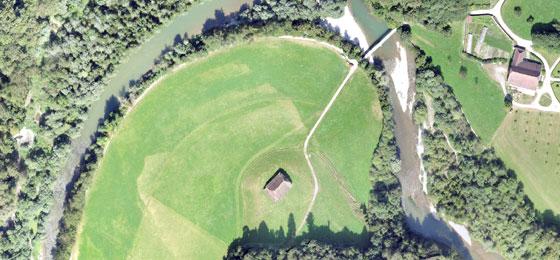An experimental flood to revitalise rivers

Scientists working on NRP 70 "Energy Turnaround" plan to take advantage of an experimental flood on the Sarine River (also known as the Saane) to assess its benefits to the river-floodplain habitat.
On 14-15 September, the energy provider Groupe-E intends to release water from the Rossens dam (northern end of the Lake of Gruyères) to create an experimental flood in the Sarine River. At its peak, the discharge rate will reach 255 m3/s, around a hundred times more than the regular flow. The goal is to flush the river bed and limit the growth of nuisance algae.
Scientists plan to take advantage of this exceptional event to evaluate whether this kind of flooding can benefit the environment. This study is part of the "Sustainable floodplain management and hydropower" project of the National Research Programme "Energy Turnaround" (NRP 70).
Under new Swiss legislation, the cantons are required to address the issue of sediment trapped by dams, which impacts on the ecology of the rivers further downstream. Below dams, sediment on the river bed is continuously moved downstream and becomes depleted, which lowers the water levels. Flows are too low to regularly inundate the adjacent floodplain and the natural flow dynamic is also lost. "The residual flows commonly found below dams tend to be constant and create homogeneous habitats that go hand in hand with less biodiversity," says Diego Tonolla from Zurich University of Applied Sciences (ZHAW). "Experimental flooding and sediment replenishments are two measures that together could alleviate these issues."
Drones follow the flood
Some 1000 m3 of sediments will be deposited in several places along the river. A joint team from ZHAW, EPFL and EAWAG will study their transportation and velocity by tracking pebbles using RFID (Radio Frequency Identification) techniques. Sonar-like devices will record the flow velocity and water depth as the flood propagates. Drones will be deployed to monitor the water dynamics during the experimental flood as well as to quantify the erosion and deposition patterns of different habitats. Finally, scientists will collect aquatic insects and microbial communities before, during and after the flood in order to quantify the impacts on biodiversity.
The findings will be compared with the natural Sense River. "We expect them to improve our understanding of experimental floods as a management tool for river restoration," says Tonolla.
Research for the energy turnaround
Since 2015, the National Research Programme "Energy Turnaround" (NRP 70) has been developing technological and scientific solutions to put in place a new energy system for Switzerland. Like the associated programme "Managing Energy Consumption" (NRP 71), which is focusing on the socio-economic issues raised by the energy turnaround, NRP 70 has been mandated by the Federal Council and is being overseen by the Swiss National Science Foundation. NRP 70's "Sustainable floodplain management and hydropower" project is developing tools to identify, measure and reduce the environmental impact of dams.